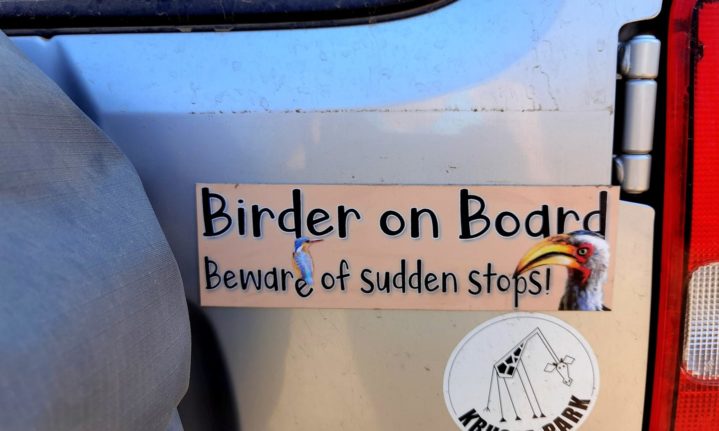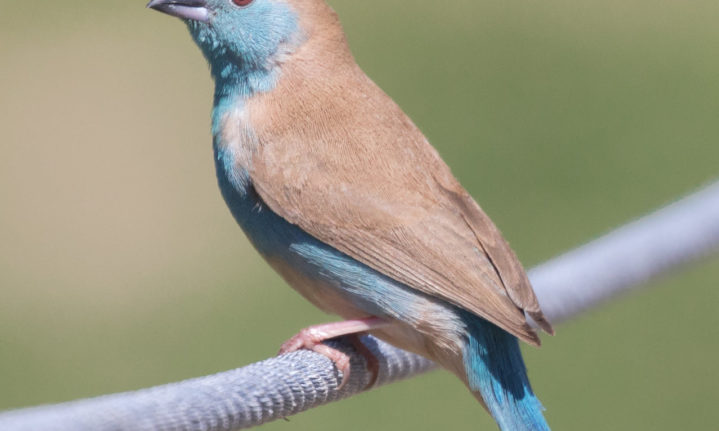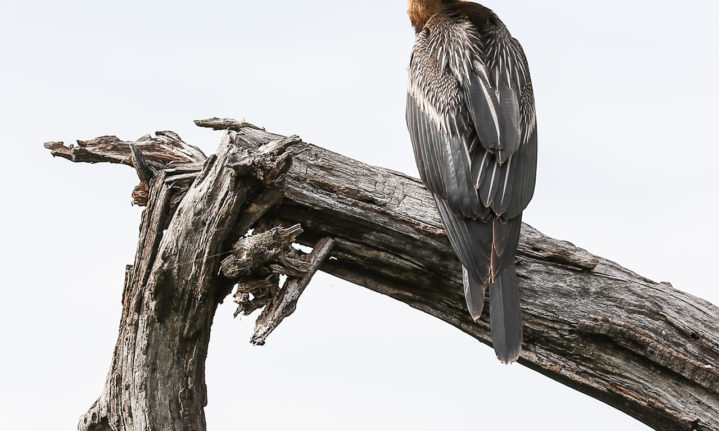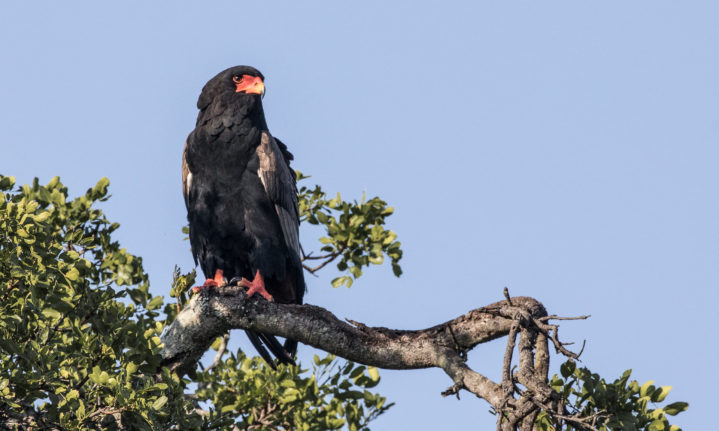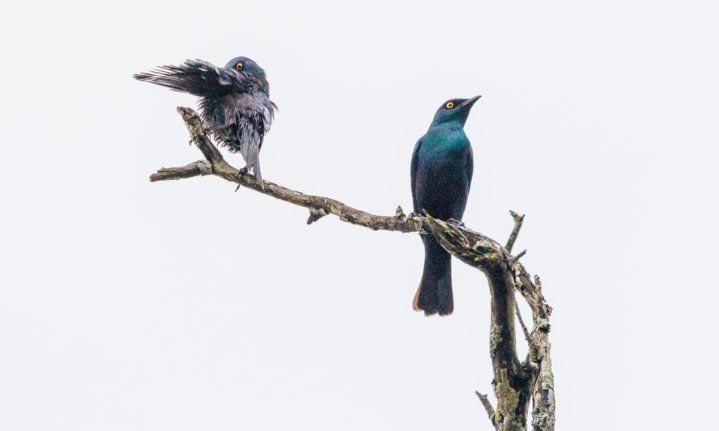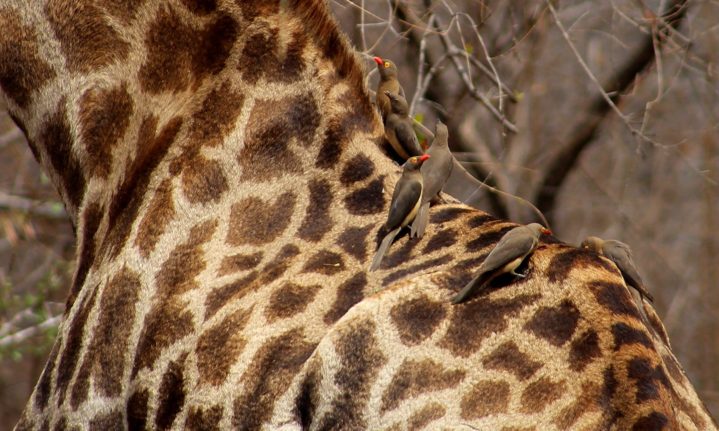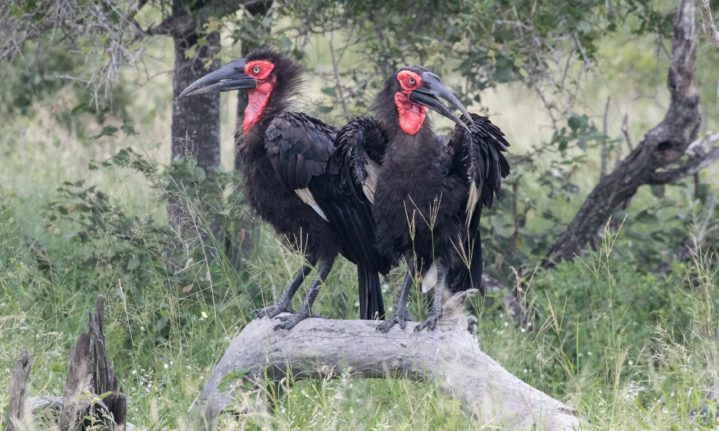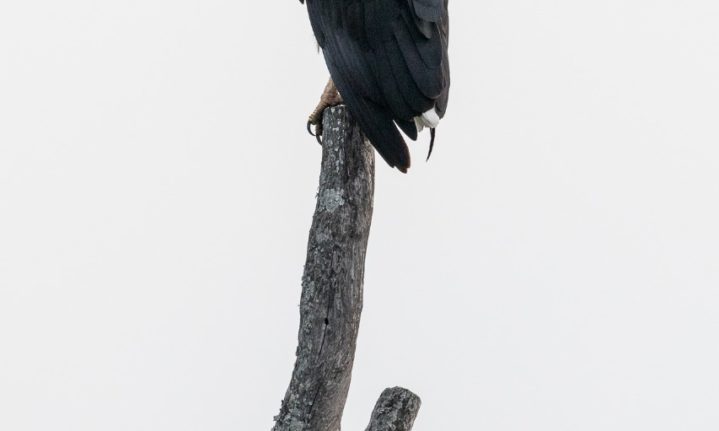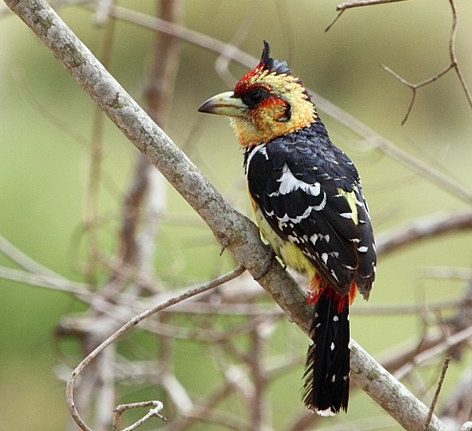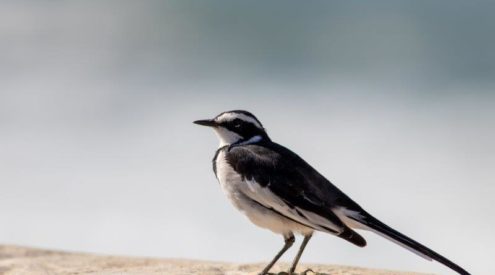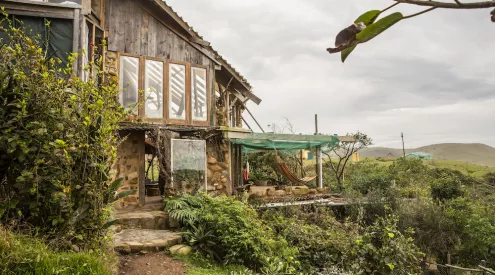With around 500 species of birds in Kruger, the national park is a birdwatcher’s paradise. But it may not be for everyone. We’ve all sat impatiently behind a car full of people with their binoculars out, straining to catch a glimpse of a bird only to find they’re examining a little brown job in a thorn tree. But it’s worth joining in that excitement and jumping on the birdwagon, because being able to identify even a few birds can make a drive in Kruger so much richer. Who knows, maybe your car will be sporting a “Birder on Board” bumper sticker on your way out the park.
These are ten easy to identify birds that are found all year round in Kruger:
Southern Yellow billed hornbill
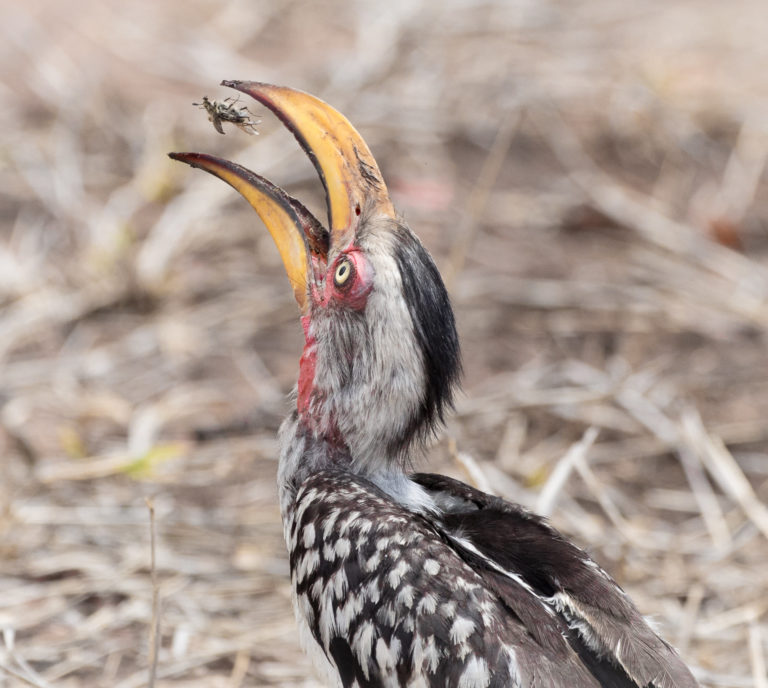
Photo: Anton Crone
Likely one of the first birds you’ll spot in Kruger is the yellow billed hornbill. They feed off the ground and are often next to the roads in the park. They are also common, bordering on pesky, visitors to the camps and picnic sites of Kruger.
Identifying features:
-Large hooked yellow bill
-Red around the eyes
-Black and white plumage
Yellow billed hornbills are a sociable species, often seen in small groups. They have a distinctive “clucking call” that multiple birds will join in on, often rocking back and forth and working up to a crescendo then fading away. They are often seen alongside the Red billed hornbill, which has very similar plumage but is slightly smaller and has a distinctive red bill.
Lilac breasted roller
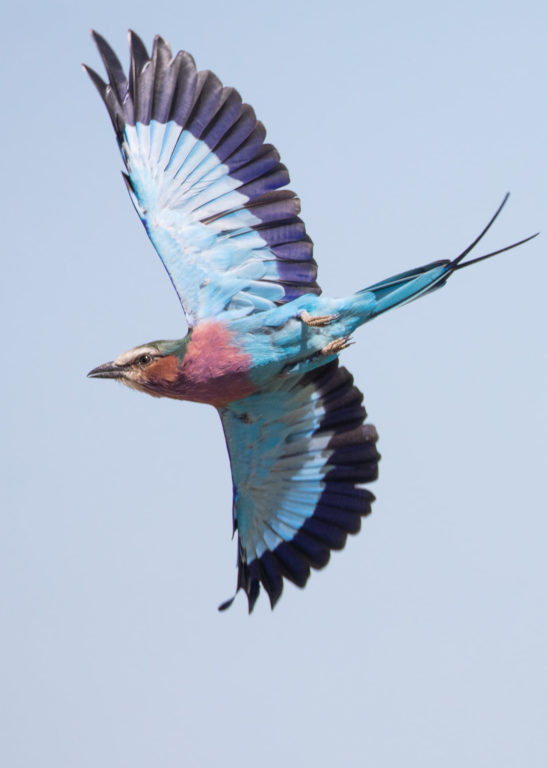
Photo: Anton Crone
Lilac breasted rollers are amongst the most beautiful and vibrant birds in the park. With a distinct lilac chest, green head and turquoise underbelly, they stand out in Kruger’s veld and are often seen on open perches and telephone poles along the side of the road. They prey on insects like grasshoppers and locusts, often swooping down from a high perch to catch them. They are easy to spot when flying, with an eye-catching light and dark blue underwing.
Identifying features:
-Vivid lilac chest
-Green back of head
-Turquoise underbelly
-Bright blue underwings
-Long straight tail shafts
Lilac breasted rollers could be confused with the less common Purple roller, which is bigger, less vivid in colour and has a square tail as opposed to tail shafts. The call of a lilac breasted roller does not match its beauty, as they utter harsh rattling vocalisations.
Cape glossy starling
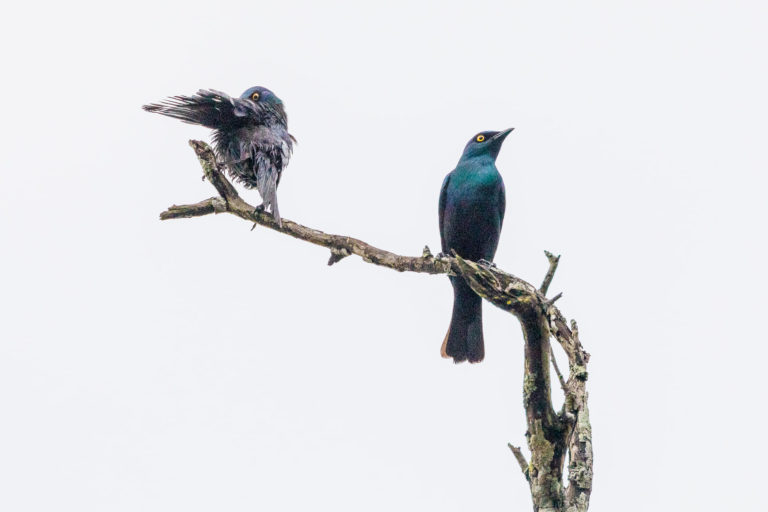
Photo: Anton Crone
By far the most common starling in the park, the cape glossy starling is a guaranteed sighting in Kruger, especially around the camps and at picnic sites. Like the hornbill, they are not to be trusted around a picnic table. (If given the chance, they will swoop out of the trees and steal your bacon right off of your skottel!) Their glossy coat changes in colour depending on the light, appearing dark blue in poor light and an almost peacock blue green in good light
Identifying features:
-Glossy blue green plumage
-Uniform plumage (compared to other starlings like the blue-eared starlings who appear similar but are less common)
-Bright yellow eye
Glossy starlings are usually found in pairs and small groups and have a pleasant warbling, whistling call.
Red billed oxpecker
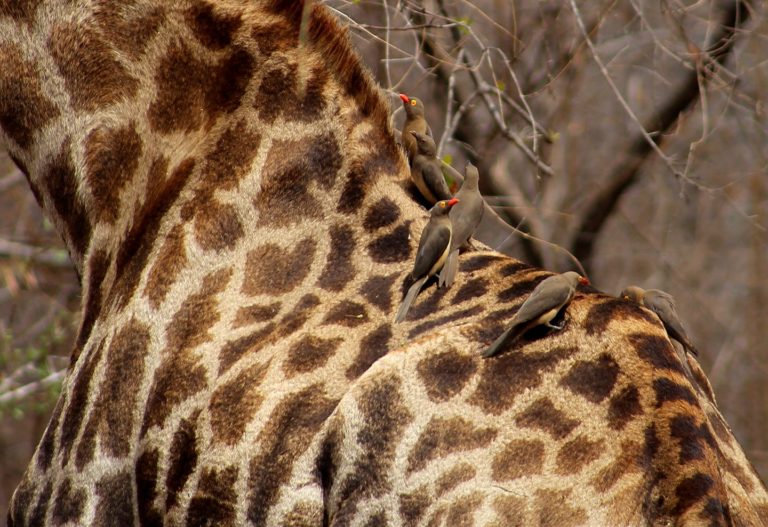
Photo: Lauren Dold
To spot these birds, you need to first spot animals. You’ll find them on the backs, heads and ears of impala, buffalo, giraffe and other mammals. They spend their days picking ticks and other parasites from the hides of animals, and will also trim any wounds the animal may have. Everybody wins! The oxpeckers get a meal, eating sometimes hundreds of ticks a day, while the host animals get cleaned of bothersome parasites, minimising the time they would otherwise need to spend grooming.
Identifying features:
-Bright red bill
-Red eye surrounded by fleshy yellow wattle
-Plain brown olive plumage with light cream underbelly
-Short tail
They have a distinct “tsik-tsik” call, which game guides often listen out for as that could lead them to sightings of animals.
Blue Waxbill
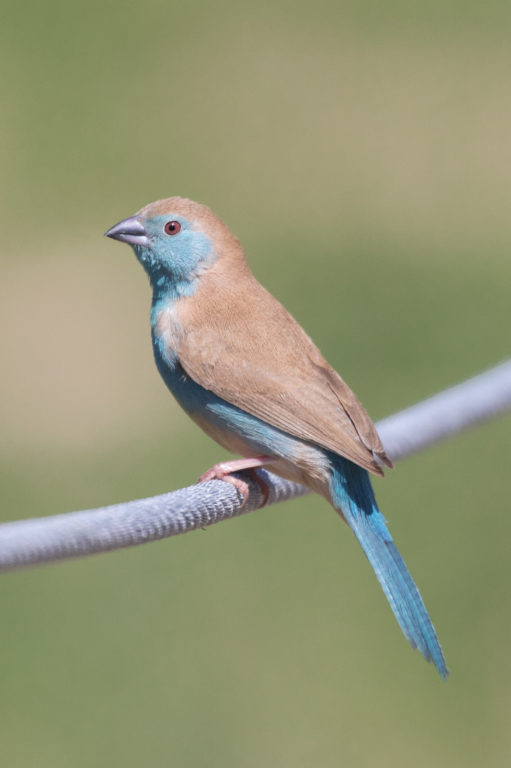
Photo: Anton Crone
These little birds are a joy to watch near waterholes, where they are easiest to spot. The first thing to look for when identifying a blue waxbill is their size (tiny), and the distinct powder blue plumage. They are often seen in pairs or small groups, dashing between low tree branches and sources of water.
Identifying features:
-Powder blue face, breast and rear
-Pale brown wings and head
-Small dark brown eyes
-Grey legs
Blue waxbills feed mostly on the ground on grass seeds. They make quite a high pitched “tsee tsee tsee” call in quick succession.
African Darter
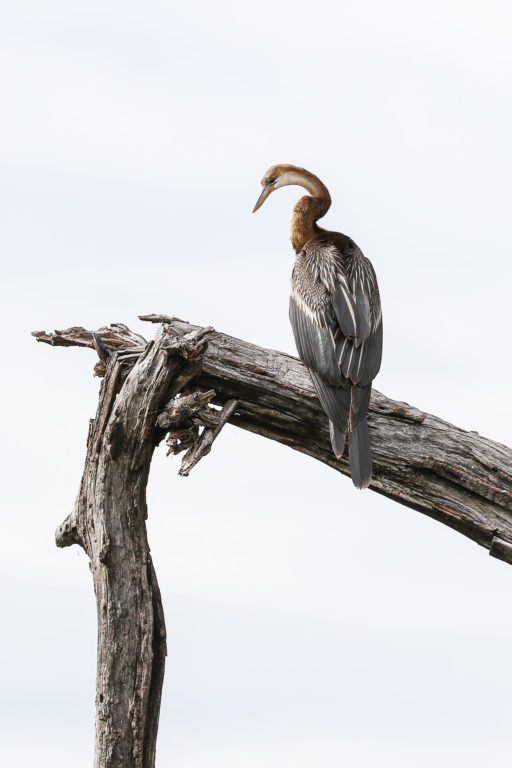
Photo: Anton Crone
The African darter, sometimes called the snake bird for its s-shaped neck, is a common waterbird found throughout the Kruger (and many other parts of South Africa). They prefer placid water to flowing rivers, and are often spotted around Kruger’s dams. To give yourself a good chance of spotting one, visit one of the waterside hides situated at some of the rest camps and next to dams throughout the park.
Identifying features:
-Long S-shaped neck
-Straight sharp bill
-Mature darters are mostly black with white flecks and streaks
-Males have a rust coloured neck with a white stripe from the eye down the side of the head
-Females and juveniles plain brown
Darters may be confused with cormorants, a similar looking water-dwelling bird, but there are some differences to look out for. Cormorants, of which there are two species in Kruger, have slightly hooked bills, while darters have straight bills used for impaling fish, and their necks are longer and thinner. They may be spotted side by side as they share the same habitat.
Crested Barbet
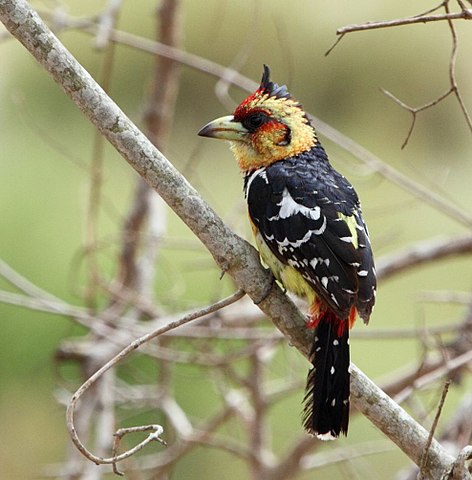
Photo: Alan Manson
Crested barbets are chunky little birds with red, yellow, black and white feathers. They are mostly spotted in wooded savannah and riverine forests, but are also commonly seen in Kruger’s rest camps.
Identifying features:
-Speckled red and yellow face with pointed black crest
-Black and white feathers on the wing
-Black and white plumage on the chest, like a napkin, with red and yellow underbelly
-Small red patch on rump, longish black and white tail feathers.
Barbets are often seen hopping on the ground foraging for food, or in hollow tree holes in which they nest. The call of a crested barbet is an incessant, dry insect-like trill, like a muffled alarm clock.
Southern ground hornbill
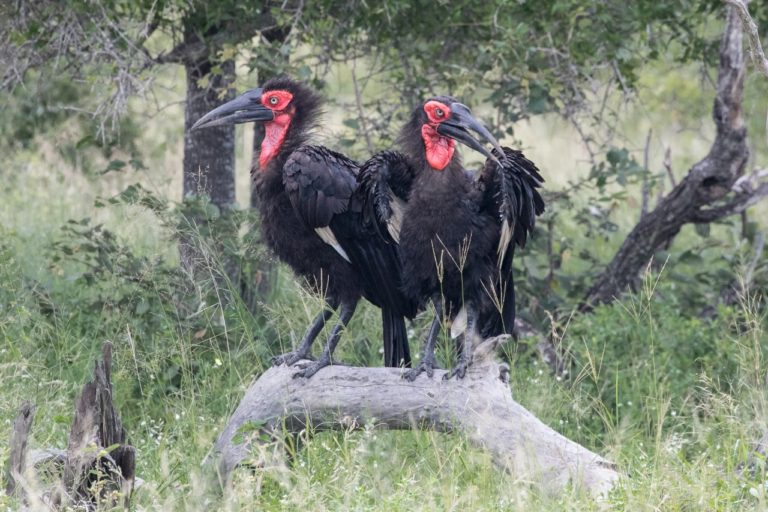
Photo: Anton Crone
While not a common bird, southern ground hornbills would be considered a fairly common sighting in the Kruger. Much larger (the world’s largest hornbill in fact) than their common tree-dwelling cousins, the ground hornbill is listed as endangered in South Africa, with only an estimated 400 breeding females left. However, they are often seen in groups of three (usually parents and a juvenile) walking next to or on the roads in Kruger, and occasionally in trees.
Identifying features:
-Large birds, up to 1m in height (about the size of a turkey)
-Black plumage
-Bright red, bare face with red throat pouch
-Females have a mostly red face and throat pouch with a small blue batch below the black bill
-Juveniles have pale yellow facial skin and pouch
-Large wingspan, with white feathers underwing in flight
Ground hornbills eat a range of prey, from insects to small reptiles, rodents and frogs. They sometimes scavenge on roadkill in Kruger, like snakes that have been run over. They have a number of calls, but the most common is a very low, four note utterance that can be heard up to 3km away. It is common to hear this call in the early hours of the morning in Kruger.
Visitors to Kruger are encouraged to report sightings of ground hornbills to help researchers keep track of their locations, habits and numbers.
Email [email protected] or whatsapp sighting details (date, location, number of birds) to 079 754 6234, including photos if possible.
African Fish Eagle
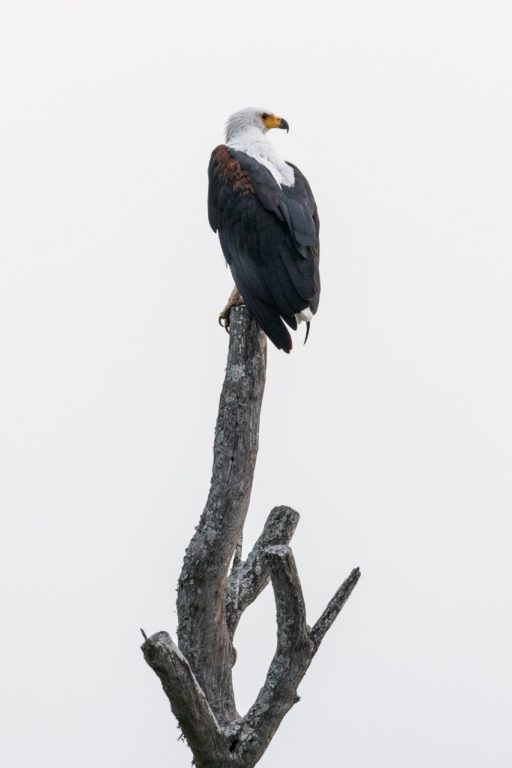
Photo: Anton Crone
Fish eagles are among the most commonly sighted raptors in Kruger, seen usually along riverbanks and near dams. They are often heard before they are seen, as they have a very distinct ringing, far-carrying call.
Identifying features:
-White head and upper breast
-Brown lower breast
-Dark brown wings
-Yellow beak with black tip
-Yellow legs
Fish eagles are often seen in pairs, throwing their heads back when vocalising. As their name suggests, fish eagles prey on fish, often caught live. They also sometimes steal prey from other birds such as goliath herons.
Bateleur
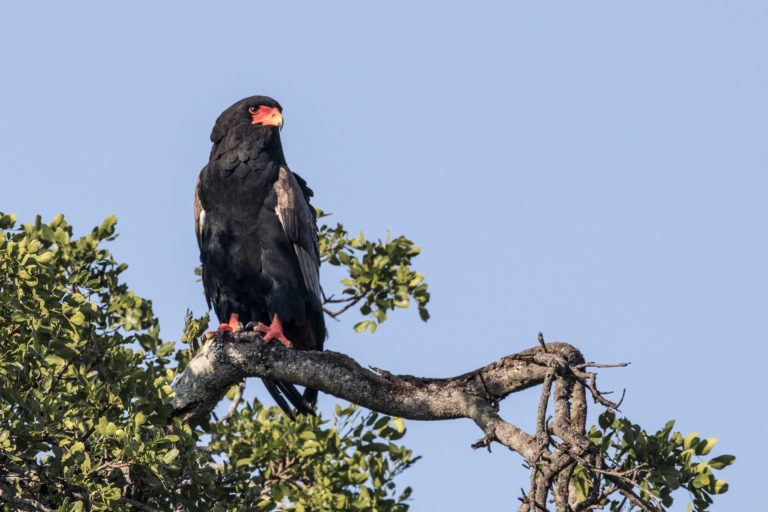
Photo: Anton Crone
Another common raptor in Kruger, the bateleur is often spotted gliding low level over the veld and is easy to identify from below. They are fairly bulky looking, not easily confused with other raptors (with the exception of juveniles, with dull brown or mottled immature plumage that can be confusing).
Identifying features:
-Black plumage on head and chest
-Red facial skin
-Yellow beak with black tip
-Red legs
-From below, male has wider black trailing edge on wong, while female wine mostly white with thin black edge
Bateleurs prey mainly on rodents and small animals, and also feed on carrion. “Bateleur” means “juggler” or “entertainer” in French, so-called because of their inflight aerobatics, twisting and rocking as they fly.
Remember that if you love birds, you’re doing them no favours by feeding them in Kruger. Feeding birds causes unnatural behaviour, which can be seen at many of the picnic sites throughout Kruger. Leaving food out also attracts monkeys, baboons, honey badgers and hyenas, all of whom now associate camps and picnic sites with food.










